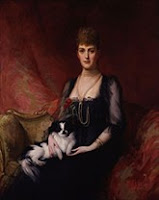The other day I was really missing my border terrier, Wrigley. [There’s a picture of him at the end of this article] To give me some ‘doggy time’, without the food, walks and visits to the vet, I went on a research “trip” to try and determine when it became popular to own a lap dog.
A lap dog or lapdog is a breed of dog that is both
small enough to be held in the arms or lie comfortably on a person's lap and
temperamentally predisposed to doing so.
Lap dogs are animals with no purpose other than companionship. The tiny dogs, bred for their size, have been around since at least the 8th century in China.
In the 18th century, both in Britain and in the rest of Europe, it became popular to own a lap dog, especially by those who had the leisure and resources to keep an animal that wasn’t working or used as a food source.
These little canines were considered members of the family, some
people even going so far as to formally grieve the passing of their pint-sized
pooches. In 1887, Ludwig van Beethoven composed an elegy on the death of a
poodle, Elegie auf den Tod eines Pudels.
In addition to their being kept as a pet and providing warmth, lap dogs have been fashion accessories and status symbols, and even to attract fleas away from their owners. Recent genetic study confirms that the Pekingese lapdog, bred in ancient China to fit inside the sleeves of a man's robe, is one of the oldest breeds of dog. For centuries, they could only be owned by members of the Chinese Imperial Palace. Similarly ancient are the lapdog ancestors of the modern breeds of Tibetan Terrier, Lhasa Apso, Pug, and Shih Tzu. In the book De Canibus Britannicis published in English in 1576, lapdogs are described as a type of dog, such as the "Spaniel Gentle” or “Spaniel Comforter". Ancestors of the modern breed of Cavalier King Charles Spaniel [seen in this portrait of Mimi, Madame De Pompadour's lap dog] were a type of "Spaniel Gentle" kept by English nobility in the 17th century. Modern breeds of lapdog also include the Bichon Frise, Japanese Terrier, Maltese, Pomeranian, Yorkshire Terrier and many others.
Tracy Garrett (and Wrigley)





Really interesting blog, Tracy.
ReplyDeletePets are good for people, I agree.
Your Wrigley looks full of character and affection.
Thanks for sharing.
A lovely read. I always had large dogs, but now I'm less mobile I got a little one and am totally converted to their spirit and fun. Wrigley is adorable.
ReplyDeleteThanks for the background on very special animals. Doris
ReplyDeleteGreat article, and the Queen of England and her Corgis doggies carry on this tradition.
ReplyDeleteI've enjoyed the company of all sizes of dogs, but I lean toward the small and lap sitters. Right now, I have three senior rescues: a Dachshund and two Jack Russell terriers. It would be an empty house without them.
ReplyDelete